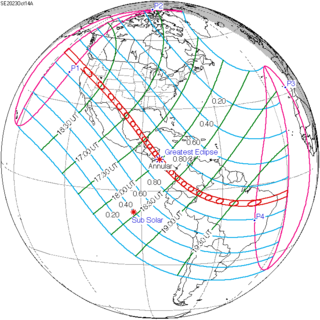
Back كسوف الشمس 14 أكتوبر 2023 Arabic Сонечнае зацьменне 14 кастрычніка 2023 года Byelorussian Eclipse solar del 14 d'octubre de 2023 Catalan Sonnenfinsternis vom 14. Oktober 2023 German Eclipse solar del 14 de octubre de 2023 Spanish خورشیدگرفتگی ۱۴ اکتبر ۲۰۲۳ Persian Éclipse solaire du 14 octobre 2023 French Eclissi solare del 14 ottobre 2023 Italian 2023년 10월 14일 일식 Korean Zonsverduistering van 14 oktober 2023 Dutch
| Solar eclipse of October 14, 2023 | |
|---|---|
 Annular Solar Eclipse as viewed within 170 meters (560 feet) of the eclipse centerline and within 1 second of maximum eclipse (Hobbs, New Mexico, USA). | |
| Type of eclipse | |
| Nature | Annular |
| Gamma | 0.3753 |
| Magnitude | 0.952 |
| Maximum eclipse | |
| Duration | 317 s (5 min 17 s) |
| Coordinates | 11°24′N 83°06′W / 11.4°N 83.1°W |
| Max. width of band | 187 km (116 mi) |
| Times (UTC) | |
| Greatest eclipse | 18:00:41 |
| References | |
| Saros | 134 (44 of 71) |
| Catalog # (SE5000) | 9560 |
An annular solar eclipse occurred at the Moon’s descending node of orbit on Saturday, October 14, 2023,[1][2][3][4][5][excessive citations] with a magnitude of 0.952. A solar eclipse occurs when the Moon passes between Earth and the Sun, thereby totally or partly obscuring the image of the Sun for a viewer on Earth. An annular solar eclipse occurs when the Moon's apparent diameter is smaller than the Sun's, blocking most of the Sun's light and causing the Sun to look like an annulus (ring). An annular eclipse appears as a partial eclipse over a region of the Earth thousands of kilometres or miles wide. Occurring only 4.6 days after apogee (Apogee on October 10, 2023), the Moon's apparent diameter was small.
- ^ Cite error: The named reference
spacewas invoked but never defined (see the help page). - ^ Cite error: The named reference
nprwas invoked but never defined (see the help page). - ^ Cite error: The named reference
nytwas invoked but never defined (see the help page). - ^ Cite error: The named reference
pbswas invoked but never defined (see the help page). - ^ Cite error: The named reference
cbswas invoked but never defined (see the help page).
